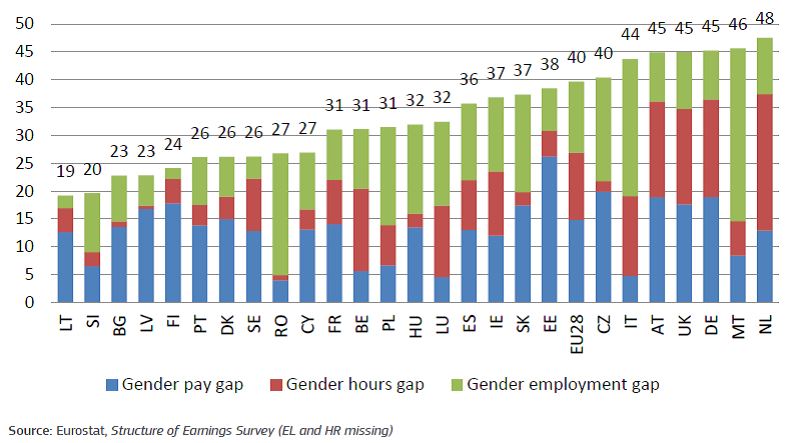Total Earnings Gap
Several indicators measure the different types of disadvantages women face. The European Commission adds three types of discrimination - gender pay gap, gender hours gap and the gender gap in employment - and composes the total earnings gap. The rational behind is that these "disadvantages combine and mutually reinforce each other so as to create an overall problem deeper than each of its components".
The total earning gap is calculated on the basis of the ‘Structure of earnings survey’ and updated every 4 years.
By definition, the total earnings gap shows higher figures than its components.
Inhaltsverzeichnis
Sub-Indicators
Gender Pay Gap
The gender pay gap measures the difference in hourly wage of employed men and women in full-time equivalents.
Gender Hours Gap
The gender hours gap measures the number of paid working hours.
Gender Gap in Employment
The gender gap in employment measures the difference in employment rates of women and men.
Analysis
As a short analysis, the total earnings gap shows more details than single indicators. Malta presents an interesting example here: the country has a relatively small gender pay gap, however, faces the highest total earnings gap. The gap in employment rates are in comparison to other European countries extremely high, causing a very high earnings gap. This picture can be explained by the fact that women in malto often do not re-enter the labour market after family-related breaks.
Other countries, such as the Netherlands, UK, Austria and Germany, have a relatively high total earnings gap due to the hig number of women working part time.
In more general terms, the total earnings gap shows a women's stand in the labour market of the respective countries and also parts of the culture. Especially interesting in this case is the combination of the hours and employments gap showing in the direction how much time women spend on family-related unpaid work and how gender roles are divided within countries.
References
European Commission (2017). Report on Equality Between Women and Men in the EU, see p. 25.
Eurostat: Gender Overall Earnings Gap
